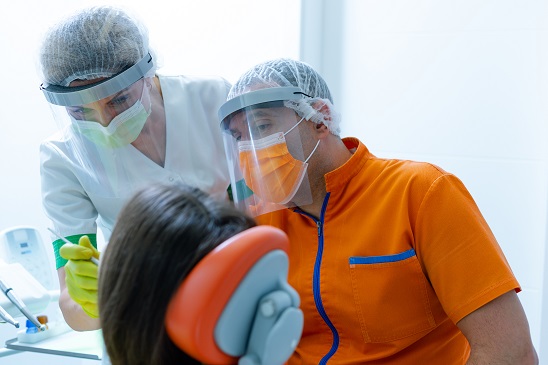The coronavirus pandemic has altered so much of our daily routines that it’s almost tough to remember how things were before it swept through our country. As a result, healthcare facilities and businesses have all adapted to new ways of doing business. Dental care may have been a step ahead of the game as most dentists were used to practicing fairly strict protocols against the spread of common illnesses. Nevertheless, the coronavirus has forced them to take extra precautions to keep both patients and staff safe. For this reason, going to the dentist is a different experience these days.
Unfortunately, modern dentistry puts oral healthcare professionals and their patients at high risk of catching an infectious disease. At the beginning of the outbreak, most practices closed down for everything except emergency procedures.
CDC Guidelines for Infection Prevention at Dental Facilities
As some states began to slow their rates of infection, the American Dental Association (ADA) and the CDC started to advise dental professional regarding best practices for reopening. To help dentists, the CDC released a set of guidelines for infection prevention at dental care settings.
- Recognize dental settings have unique characteristics that warrant specific infection control considerations.
- Prioritize the most critical dental services and provide care in a way that minimizes harm to patients from delaying care and harm to personnel and patients from potential exposure to SARS-CoV-2 infection.
- Proactively communicate to both personnel and patients the need for them to stay at home if sick.
- Know the steps to take if a patient with Covid-19 symptoms enters your facility.
Revised Guidelines from the CDC
At the end of August, the CDC updated these guidelines with more information about physical distancing and how to respond to SARS-CoV-2 exposures among dental healthcare personnel and patients. They also reorganized the material into two categories:
- Recommended infection prevention and control practices for routine dental healthcare delivery
- Recommended practices when providing dental healthcare for a patient with suspected or confirmed SARS-CoV-2 infection.
Consequently, dental practices have made it a priority to disinfect all surfaces and tools more regularly, clean and replace tools between uses, and wear more protective gear than usual. For instance, the CDC recommends that, in areas with moderate to substantial community transmission, dental practitioners should wear eye protection in addition to a facemask and use an N95 respirator during aerosol generating procedures.
But How Much Have Things Changed?
Many of these recommendations such as surface cleaning and using personal protective equipment were already standard for many dental practices before Covid-19. Other infection control measures, however, are new for dental settings. Many practices, for example, are installing HEPA filters and using ultraviolet light to kill off germs unleashed through aerosol-generating procedures. Furthermore, there are now legal consequences in some states for practices that do not adhere to the CDC’s infection control recommendations.
Positive Long-term Effects
The CDC has also included recommendations to prevent anyone who is already infected from going to the dentist. For this reason, offices are now actively screening both patients and staff for fever or Covid-19 symptoms upon entering. For many observers, the hope is that infection control practices like these will remain standard long after the coronavirus threat dies down.
Stay Safe by Asking Questions
To stay safe, one of the best things to do to before making a dental appointment is to ask questions beforehand. Find out if people are screened over the phone before arriving at the office and whether staff are regularly tested for Covid-19.
It also helps to know if they limit the amount of people in the waiting room. In addition, you should ask how often they clean both the clinical rooms and the common areas. Ideally, patient rooms should be cleaned after each visit and other spaces should be cleaned a few times a day.
If a practice adheres to these measures, you can feel relatively safe about visiting their office. As more dental care offices reopen, it’s important that everyone be mindful of the risks and take the appropriate steps to protect both their oral health and their overall health at the same time.




